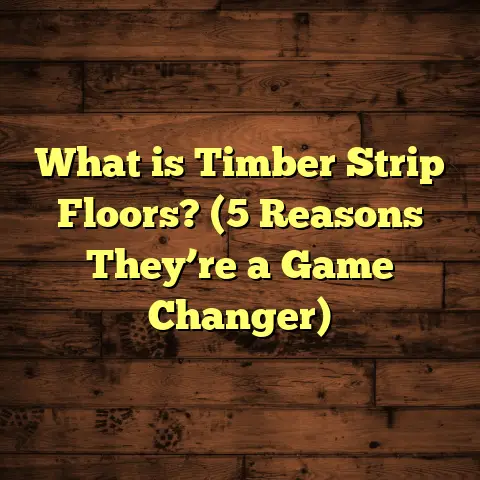What is Laminate Flooring? (5 Reasons It’s a Game Changer!)
Have you ever stopped to think about why laminate flooring has become such a popular choice in homes and businesses alike? When I first started working as a flooring contractor, I mainly installed hardwood floors. Everyone wanted that authentic wood look—it was classic, elegant, and durable. But over time, I noticed a shift. Laminate flooring began popping up everywhere. It wasn’t just a trend; it was changing how people think about flooring options altogether. I’ve been involved in hundreds of installations, and I can confidently say laminate has earned its place as a true game changer in flooring.
Let me share with you five reasons why laminate flooring stands out so much—backed by my personal experience, industry data, and real project stories. I’ll also sprinkle in some technical details and practical advice so you get the full picture.
1. Affordable Style That Doesn’t Feel Cheap
When a client first says, “I want hardwood but it’s out of my budget,” I immediately think of laminate. It’s amazing how far technology has come to recreate the look of real wood or stone with laminate flooring.
Why the Price Difference?
I did a little digging with some recent market data to compare average costs:
| Flooring Type | Average Cost per Sq Ft (Material + Installation) |
|---|---|
| Hardwood | $7 – $14 |
| Laminate | $2 – $6 |
| Luxury Vinyl Plank | $3 – $7 |
| Carpet | $1 – $5 |
Laminate typically costs less than half of hardwood for an equivalent area when you factor in materials and installation. This price difference means you can cover more square footage or choose a higher grade of laminate without breaking the bank.
How Does Laminate Look So Good?
Laminate’s upper surface is made from a high-resolution photographic layer sealed with a transparent wear layer. The photographic image can mimic anything from cherry wood to slate tile down to the grain patterns and color variations.
Some laminates even have embossed textures matching the printed image—giving you the feel of real wood grain when you run your hand across.
I recall a kitchen remodel where the client wanted whitewashed oak flooring but couldn’t afford the real thing. We installed laminate planks with an embossed oak texture, and when guests visited, many thought it was the genuine article.
Beyond Wood: Variety Expands Your Design Options
Laminate isn’t limited to wood looks either. You can get:
- Stone effects (marble, granite)
- Concrete or industrial styles
- Exotic wood patterns from tropical species
- Even colorful or patterned designs for creative spaces
This variety means laminate fits well in nearly any décor style—from rustic cabins to modern lofts.
2. Installation Made Simple: Save Time and Money
If you’ve ever been involved in a home renovation, you know how disruptive flooring projects can be. Traditional hardwood floors require nailing or gluing down planks, sanding, and finishing onsite—processes that can take days or weeks.
Laminate floors changed this game completely.
The Click-Lock System
Most laminate flooring uses a click-lock or floating floor system where planks snap together without glue or nails. This method offers several benefits:
- Faster installation: A typical 300-square-foot room can be installed in one or two days.
- DIY friendly: Many homeowners successfully install laminate themselves using just basic tools.
- Less mess: No fumes from adhesives or dust from sanding.
- Easier repairs: Damaged planks can be replaced individually without pulling up the entire floor.
In my experience, a professional installer working on laminated floors can complete jobs 30-50% faster than traditional hardwood installations.
Real Case Study: Speed Wins
Last year, I worked on a commercial project converting an old office into a coworking space. The client had a tight deadline—they needed floors down before tenants moved in.
We chose laminate with an AC4 rating (more on that later) for durability and quick installation. Our team completed 1,200 square feet in just three days—a job that would have taken at least a week with hardwood or tile.
The client was thrilled not only with the timeline but how quickly they could start using the space.
3. Durability Built for Real Life
I’ve seen plenty of floors over my career that look beautiful on day one but show wear and tear quickly. With laminate, durability is often its biggest selling point.
What Makes Laminate Durable?
At the core of laminate’s durability is its layered construction:
- Wear Layer: A transparent top coat made of melamine resin or aluminum oxide protects against scratches and stains.
- Decorative Layer: The photographic image that gives laminate its appearance.
- Core Layer: High-density fiberboard (HDF) or medium-density fiberboard (MDF) provides strength and stability.
- Backing Layer: Adds moisture resistance and support.
This multi-layer design means laminate resists dents better than softer hardwoods like pine or maple.
Abrasion Criteria (AC) Ratings
Laminate floors come with an AC rating indicating their wear resistance:
- AC1: Light residential use (bedrooms)
- AC2: Moderate residential use (living rooms)
- AC3: Heavy residential use / light commercial
- AC4: General commercial use
- AC5: Heavy commercial use
For most homes, AC3 or AC4 laminates are ideal. They hold up well against pets, kids, and daily foot traffic.
Water Resistance
Early versions of laminate struggled with moisture damage, but technology has improved dramatically. Some brands now offer water-resistant or waterproof laminates suitable for kitchens, bathrooms, and even basements.
In one project, I installed waterproof laminate in a basement family room prone to humidity. After two years, the floor looks flawless despite occasional spills and damp conditions.
Real-Life Durability Story
I once helped a family replace carpet in their playroom with laminate flooring rated AC4. They have three kids who constantly drop toys, spill juice, and drag furniture around.
Two years later, the floor still looks great—no scratches or stains visible anywhere. The parents were amazed at how well it held up and how easy it was to clean compared to carpet.
4. Maintenance That Fits Busy Lives
If you have children or pets—or just don’t want to spend hours on upkeep—you’ll appreciate laminate’s ease of maintenance.
Regular Care Is Simple
Unlike hardwood floors that need refinishing every few years and special cleaners to avoid damage, laminate is pretty carefree:
- Sweep or vacuum regularly to remove dirt particles that could scratch the surface.
- Use a damp mop with mild detergent for cleaning—avoid soaking water which can seep between planks.
- Wipe up spills promptly to prevent moisture damage.
I often tell clients that maintaining laminate is about consistent, gentle care rather than intense periodic treatment.
No Waxing or Polishing
Hardwood floors often require polishing or refinishing to restore shine and protect the surface. Laminate’s wear layer eliminates this need entirely.
This saves homeowners money on professional services and time spent on maintenance chores.
Longevity Through Proper Care
Properly maintained laminate flooring can last 15-25 years depending on quality and usage. Compared to carpet’s typical 5-10 year lifespan before needing replacement, this makes laminate a smart investment over time.
5. Environmental Impact: Modern Laminate Gets Greener
You might not expect laminate flooring to be an eco-friendly choice at first glance—it’s manufactured wood composite after all—but there are some important environmental aspects worth noting.
Use of Recycled Materials
Many brands now incorporate recycled wood fibers into their core boards instead of relying solely on virgin timber. This helps reduce deforestation and preserves natural forests.
Certifications Matter
When selecting laminate for eco-conscious projects, look for certifications such as:
- FSC (Forest Stewardship Council): Ensures raw materials come from responsibly managed forests.
- FloorScore: Indicates low VOC emissions contributing to better indoor air quality.
- GREENGUARD Gold: Certifies products meet strict chemical emissions limits.
I’ve worked on several green building projects where these certifications were requirements for material approval.
Longer Product Life = Less Waste
Durable floors that don’t need frequent replacement reduce waste going to landfills. Laminate’s long lifespan combined with repairable planks means less environmental impact over time compared to short-lived carpet or vinyl options.
Sustainable Manufacturing Advances
Some manufacturers have improved production processes to reduce waste and energy use during manufacturing. For instance, using water-based adhesives instead of solvents lowers harmful emissions.
Bonus Insight: How Laminate Performs in Different Rooms
One question I get often is: “Can I use laminate everywhere?” The answer depends on the specific product and room conditions.
Living Rooms & Bedrooms
These are ideal spaces for most laminates. Moderate foot traffic and low moisture levels allow for excellent performance with mid-range AC3 laminates.
Kitchens & Bathrooms
Traditional laminates may not handle high moisture well here. However, newer water-resistant laminates designed for wet areas are expanding these possibilities.
If you’re considering laminate in these rooms:
- Choose products labeled water-resistant or waterproof
- Ensure proper underlayment and installation to prevent moisture penetration
- Maintain good ventilation to minimize humidity buildup
Basements & Below-Grade Areas
Moisture is always a concern in basements. Waterproof laminates combined with moisture barriers underlayments can make this feasible but requires careful installation practices.
Some Technical Nuances You Might Find Useful
As someone who’s installed dozens of different brands and types of laminate, here are some tips I’ve picked up regarding product selection:
- Thickness matters: Most laminates are 6mm to 12mm thick. Thicker boards tend to feel more solid underfoot and reduce noise.
- Underlayment types: Use foam or cork underlayment for sound absorption and cushioning; some laminates come pre-attached with underlayment.
- Edge styles: Square edges give a smooth look; beveled edges add dimension and emphasize individual planks.
- UV resistance: Some laminates have UV coatings that protect against fading in sunlit rooms.
Personal Reflections from My Workbench
Over my years installing floors, I’ve seen clients’ reactions shift dramatically when they realize what laminate offers:
- One elderly couple initially skeptical about laminate’s durability were thrilled after their dog scratched their previous hardwood relentlessly without damaging their new floor.
- Young families appreciate how fast they can clean up after spills without worrying about staining.
- Small business owners love how quickly they can refresh office spaces with stylish floors that fit tight budgets.
Laminate has become my go-to recommendation for many projects because of its balance between form, function, and affordability.
Wrapping Up the Conversation
So why do I call laminate flooring a game changer? Because it breaks down traditional barriers around cost, installation complexity, maintenance demands, durability concerns, and environmental impact—all while delivering great looks that fit diverse design tastes.
If you’re weighing options for your next flooring project, consider these points carefully:
- Will quick installation save you time and money?
- Do you want durable surfaces resistant to scratches and stains?
- Is budget a major factor without wanting to compromise style?
- Are you looking for low-maintenance floors for busy lifestyles?
- Do environmental factors influence your material choices?
Laminate often answers yes to all these questions better than many alternatives out there.
Got more questions? Want advice on specific brands or installation tips? Just ask—I’m here to help based on years of hands-on experience.
Thanks for spending this time with me talking about laminate flooring! If you decide to explore it for your space, I guarantee it won’t disappoint.





